In this part 2 of our series on post away from normal live action – we look at great new spot from XYZ studios in Melbourne which exploits the most fundamental pencil drawing style to produce a dynamic and entertaining spot for Honda kids Bikes.
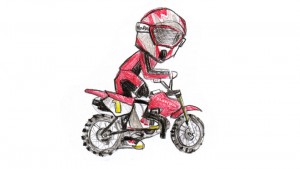
Just a few years ago traditional pencil drawings were used in preproduction for CG sequences, now the situation is reversed. In this traditional animation spot by XYZ studios, Maya was used to work out the timing and storyboarding for this pencil and line draw animation. In an age when even Disney seems to have stopped making traditional animated features – it is great to see a new generation of artists creatively expanding this art form and producing exciting results with real humanity and charm.
movielink(pencil/xyz_honda.mov,Click here to download the final spot – 3.5M)
fxguide spoke to XYZ Studio’s founder Tim Kentley.
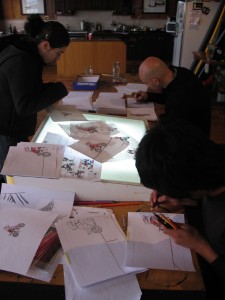
fxg: Were you involved at script development? or were the storyboards already done by the time it got to you?
The agency presented very prelim storyboards. They had the main concept of the copy “big power, big moves, small price”. Their storyboards simply had the bike on a track, riding over the type as a big mound, but we wanted to push it further than this, adding in jump ramps and having the type in the sky. We also wanted to treat the type not just as an extruded font, but with the over the top passion a kid would write the words, with pencil chrome, starbursts and the like. The agency was very open to us bringing a lot to the table in terms of how the spot worked. The actual moves of the bike and camera angles were free styled in maya around the basic concept of the type “big power, big moves, small price”
In terms of time, were briefed on the project, then had to present a proof of concept pencil test and treatment to the agency. This took about a week. From approval of this, we had 4 weeks to produce the project.
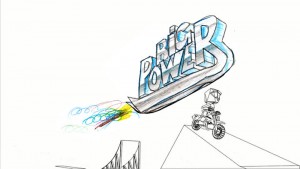
fxg: How did you do the previz ?
The previz was done in Maya. We rigged a little bike and character, set the timeline to 30sec and just free styled the action. We actually use this approach a lot now in developing really open spots. Blocking out the action in Maya, and then refining it is a great creative process – because its all real time its very fluid to arrive at a good creative solution. It also allows the client a very solid indication of how the spot works, which is unusual in the post process – normally static story boards are cut together which leaves a lot more to the minds interpretation, and can be a tricky point with a client not used to the post process – which usually means it doesn’t come together visually until the last hurdle of the pipeline. Also, because the previz was setup in Maya in real time, making client changes was quick. For example in the first pass we had the bike at the end going over ‘hoops’ a run of small mounds. Honda said that these are very dangerous for kids, so we had to change it to a small dirt jump. Maya made this easy.
movielink(pencil/PREVIZ2.mov,Click here to download the Maya previz of the spot, 4.35M)
fxg: Can you explain how the project was done?
The basic process was to model and animate in 3D, get client approval on previz. Print out all frames, hand illustrate and scan back in. 3D particles, grading and a paper texture were then added to tie it all together. We also suggested the idea of using a kids voice making sound effects of the bike for the ‘vo’ which worked well.
At the outset of the job, we discussed various techniques for coming up with a kids hand drawn look. We resolved that we wanted the hand done look, but with more energy than just a 2D series of drawings. Even though this is a very labor intensive process, a real pencil look cannot be faked in the computer. Thus, we setup the scene in 3D with the intention of printing out the animation to trace over in pencil.
Once the previz was locked off with the client, we then modeled the bike, type and rider in enough detail to give us accurate keylines to trace – adding in Honda logos and the like. Using the vector render in Maya, we were able to render out each frame as a key line drawing which was then printed out one frame per A4 sheet. We then put this frame on a light box and coloured it in with colour pencils from office works which really weren’t that great – the lead broke all the time in the sharpener!
Tim Kentley, design director and founder of XYZ is a hands on creative. He did the actual animation in Maya. He also did the camera move, which was key to adding energy to the movement of the bike. Cedric Austria was lead ‘ pencil wrangler’ and had a team of 6 helping him colour in each frame.
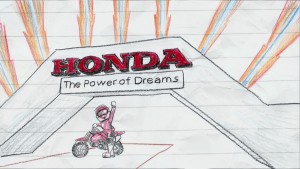
fxg: And then, once the drawings are done ?
We scanned the images back in at HD rez. In Photoshop we did basic cleanup, cloning out any pencil marks or splodges we didn’t like. The images then had a light grade to bring the colour up a touch, but we wanted to keep it looking like pencil – so not much was required.
The keylines, colouring and ‘eraser’ motion blur were all done at the same time on each A4 page.
fxg: Was the animation 2’s at any point or was it 25 drawing per sec?
This was a big discussion point. We were concerned that as the animation was done at 25fps, and it all moves very quickly, that if we illustrated at 12fps, the action may become choppy and hard to follow. Conversely, to hand illustrate at 25fps was double the work – which would have been time prohibitive. As it turned out, 12fps worked just fine – it gave a very natural look . If you have ever wondered, it takes 2 days for 1 person to scan in 375 A4 pages on 1 flatbed scanner!
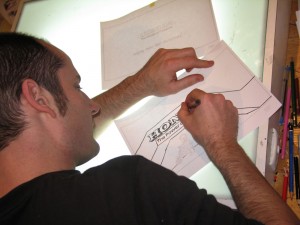
fxg: Was the hand talent just captured on the same camera over a desk as the drawing – or were the drawing comped behind the hand in the opening shot?
The hand was shot on a tripod with digital still camera. It was comped into the shot in combustion with a mask to reveal the bike. The dirt was a really fun element, to get the motion blur on the bike, we literally just put an eraser on the pencil drawings and smudged the line work. It was the fastest motion blur technique we have ever seen! we left the little bits of black rubber you get from erasing on the page as an extra element. for the exhaust, we took photos of pencil shavings, and plugged them into a particle emitter in Maya. As the spot was created in 3D, it was really simple to add the particles into the animation.
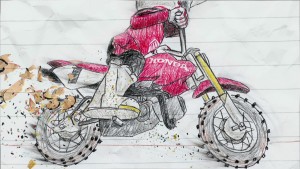
fxg: Any final thoughts on the feeling traditional media gives the spot ?
What was interesting about the creative process was the use of 3D to create 2D. For example the camera move created in 3D adds a lot of energy to the action of the bike. This would have been very difficult to achieve in 2D alone. Conversely, it would have been very difficult to achieve a realistic pencil look in 3D. So the two process work together to create a very hand done yet dynamic visual solution. We really just had a lot of fun with the spot, and evolved the technique to give us the creative result we wanted – which ended up being quite a unique visual look. And thats something we find really interesting in post – that because you are working with really cool software, you can develop entirely new visual looks in one job. Honda were so chuffed with it that they commissioned us to do a press ad for them in the hand drawn style. So at the end of the process, the agency Wilson Everard, Honda and XYZ were really please with what we achieved.
